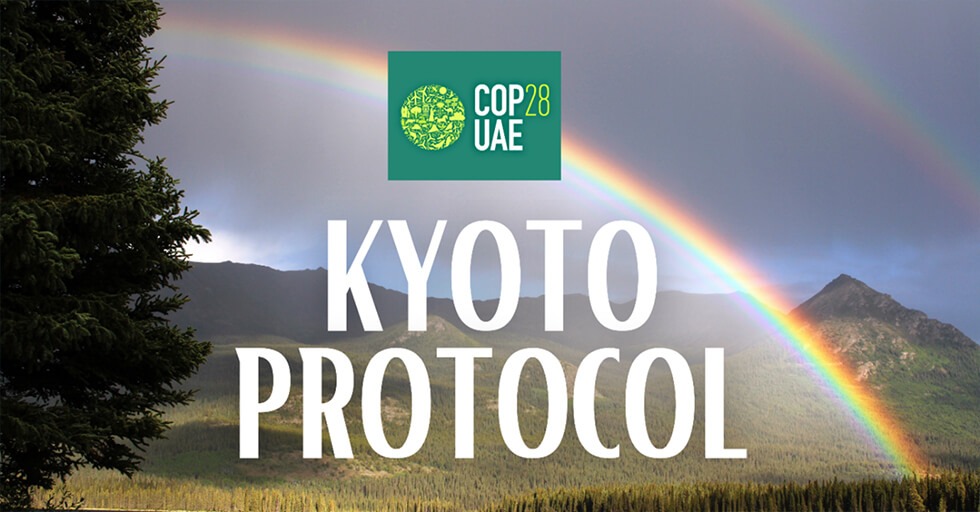The global climate event- COP28 has come to an end and it’s imperative for us to revisit one of the cornerstones of international efforts to combat climate change — the Kyoto Protocol. Established in 1997, the Kyoto Protocol marked a significant milestone in global cooperation to address the challenges posed by greenhouse gas emissions. In this blog post, we will delve into the key components of the Kyoto Protocol, examining its current relevance with the latest data available. Additionally, we’ll explore its pivotal role in guiding the discussions at the 28th Conference of the Parties (COP28).
The Kyoto Protocol: A Brief Overview
The Kyoto Protocol, officially adopted on December 11, 1997, an international treaty under the United Nations Framework Convention on Climate Change (UNFCCC), aimed to reduce greenhouse gas emissions globally, went into force on February 16, 2005, following an intricate ratification process. Presently, there are 192 Parties actively involved in the Kyoto Protocol.
In essence, the protocol serves as the practical implementation of the United Nations Framework Convention on Climate Change. It binds industrialized nations and transitioning economies to curtail and decrease their GHG emissions based on individually agreed-upon targets. The convention merely urges these countries to adopt mitigation policies and measures while periodically reporting their progress.
Relevance in the Current Context
In the current context, the relevance of the Kyoto Protocol in COP28 is paramount, as it continues to exert a substantial influence on international climate negotiations and actions. Although the initial commitment period of the Kyoto Protocol has concluded, its enduring principles play a crucial role in shaping the discourse surrounding climate change on the global stage.
One of the fundamental principles of the Kyoto Protocol that remains central to ongoing climate discussions is that it is based on the principles and provisions of the convention and follows its annex-based structure. It only binds developed countries and places a heavier burden on them under the principle of “common but differentiated responsibility and respective capabilities”, because it recognizes that they are largely responsible for the current high levels of GHG emissions in the atmosphere. In accordance with the latest available data, which underscores the urgency of addressing climate change, the principles embedded in the Kyoto Protocol gain renewed importance. The evidence of rising global temperatures, increasing frequency of extreme weather events, and the pervasive impact on ecosystems and communities necessitates a collective and differentiated response.
COP28 and Kyoto Protocol
In the face of COP28, the Kyoto Protocol will be a focal point of discussions. The conference provides an opportunity for nations to reassess their commitments, set new targets, and align their efforts with the latest scientific findings. The lessons learned from the Kyoto Protocol will guide negotiations on more ambitious emission reduction goals and strategies for adaptation and resilience.
COP28 provides a crucial platform for nations to revisit and reinforce their commitments to mitigating climate change. The lessons learned from the Kyoto Protocol guide these discussions, emphasizing the importance of equitable burden-sharing and encouraging developed nations to take the lead in reducing emissions. The differentiated approach ensures that developing nations receive the necessary support and assistance to transition to sustainable practices without compromising their developmental goals. Furthermore, the Kyoto Protocol’s emphasis on both adaptation and mitigation aligns with the contemporary understanding of climate change challenges.
Addressing the Challenges
Reflecting on the Kyoto Protocol’s achievements, notable progress has been made in raising awareness, establishing a framework for emission reduction, and fostering international collaboration. However, challenges persist, such as:
- Limited Global Participation: While 192 Parties are currently involved, some major economies- China and the United States, the top two greenhouse gas emitters, weren’t part of the agreement. China, as a developing country, wasn’t obligated to join, and the U.S. hadn’t approved the protocol.
- Evolving Emission Landscapes: The dynamic nature of emissions and the emergence of new economies pose challenges in adapting the protocol to address evolving environmental landscapes adequately.
- Adaptation and Financial Gaps: The protocol faced criticism for its limited focus on adaptation measures, and the financial resources allocated often fell short of addressing the needs of developing nations facing climate impacts.
I would like to conclude by saying that the Kyoto Protocol’s enduring influence in COP28 lies in its foundational principles, which address the historical responsibility of developed nations and emphasize the need for a collective yet differentiated approach to combat climate change. As nations convene to tackle the urgent climate crisis, I hope the protocol provides a valuable framework for shaping equitable and effective strategies in the pursuit of a sustainable and resilient future.








